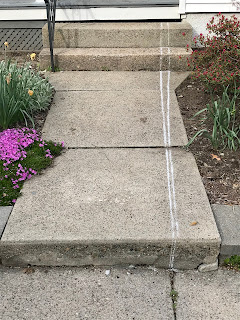Tuesday, October 5, 2021
227. Caitlin R. Kiernan's } unstable "Onion"
Saturday, July 10, 2021
226. Resident } Carolyn R.
Thursday, April 22, 2021
225. Old brown shoe } shufflers.
Caught George Harrison’s “Beware of Darkness” on the radio. “Beware of thoughts that linger…”—yes. (As inscribed on a little card plastered on the ceiling at Indica.) “Beware of soft-shoe shufflers.” Ray Bolger sings, “there was just one dance alive / the old soft shoe” in 1957; in 1953 Carol Richards sings that the old soft shoe was “the dance my daughters used to do”—that’s vaudeville. Harrison’s lyric warns of sales pitches—“beware of ABKCO.”
The “Beware of ABKCO” demo was cut in May, 1970; the Beatles finished “Old Brown Shoe” in mid-April 1969. Takes 1 & 2 of “Old Brown Shoe” were recorded on February 25th (along with first takes of “All Things Must Pass” & “Something”); Harrison has it worked out pretty good—what it lacks is Ringo (he’s out of town filming Magic Christian), McCartney’s bass, & Beatle harmonies: “Oo-ah, oo-ah-oo, oo-ah, oo-ah-oo….” A significant lack. A case can be made for the beauty of “Something” sans Beatles, but not “Old Brown Shoe.”
Harrison’s “Old Brown Shoe” lyric “If I grow up, I’ll be a singer / wear a ring on every finger” strikes me as fun—a nod toward Ringo, right? But—why “if” & not when?
Sunday, April 11, 2021
Monday, March 22, 2021
223. Color Plates & } Stories on Stage.
Color Plates began with a used copy of Sam Hunter’s Toulouse-Lautrec—to be cut-up, I thought, for poetry; instead, Hunter’s book inspired a short ekphrastic exercise.
Tuesday, March 9, 2021
222. Death Wish } & pocket nebulizers.
…the inspector is struggling with a bad cold and is using an over-the-counter inhaler, probably with neosynephrine. There were dozens of these in the ‘70s—Oxymetazoline, Ipratropium or one of the other decongestants. There was even one that combined low dose steroid and Neosynephrine. You would use it and get temporary relief and then a rebound congestion which you would again shrink with the decongestant—on and on…. The inspector is just having a recurring problem that makes him feel terrible and for which he seems unable to get more than temporary relief!
Saturday, February 27, 2021
221. "...as w/ a } quiet life...."
Two virgins, John & his “sweetheart,” adrift on a raft, find a tropical lagoon. Anchored there is a sail boat overgrown with gray fungus. John climbs aboard & explores the deck until he feels “suddenly lonely”; he locates a rope ladder so his sweetheart is able to accompany. Here they live until,
On the seventh morning, my sweetheart woke to find a small patch of [the fungus] growing on her pillow, close to her face. At that, she came to me, so soon as she could get her garments upon her. … When I saw the thing upon her pillow I shuddered, and then and there we agreed to go right out of the ship and see whether we could not fare to make ourselves more comfortable ashore.
Then I made a very horrible discovery. One morning, a little before midday, I came off the ship with a portion of the biscuits which were left. In the mouth of her tent I saw my sweetheart sitting, eating something.









